A dopant-free, single-mode optical fiber delivered accurate temperature profiles for many months in a Western Canadian SAGD well, while conventional fiber quickly succumbed to “hydrogen darkening.”
Jiten Kaura and Jose Sierra, WellDynamics
Distributed Temperature Sensing (DTS) technology promises oil companies better well and reservoir management by allowing them to permanently monitor temperature profiles along entire wells, at user-selected intervals. The technology, traditionally based on multi-mode optical fiber, has particular application in Steam-Assisted Gravity Drainage (SAGD) and steamflood recovery methods, in which steam is injected into heavy oil reservoirs to reduce the viscosity of the hydrocarbon fluid so that it can flow more freely to a producing well.
The fiber used in DTS technology normally contains dopants, such as germanium, designed to increase the refractive index of the fiber core. However, in the hydrogen-rich, corrosive environments of SAGD and steamflood applications, defects in dopant-enriched fiber may combine with hydrogen, exposing the fiber to a phenomenon known as “hydrogen darkening.” This occurrence reduces the ability of the fiber to refract light, thereby rendering it ineffective in monitoring temperature profiles.
A new DTS system, designed for long-term reliability in these harsh conditions, uses a dopant-free, single-mode optical fiber with a pure silica core and surface equipment modified to accurately and reliably take DTS surveys. The system also uses a proprietary temperature calculation algorithm that takes into consideration the effects of minor light losses resulting from hydrogen ingression in the fiber.
Japan Canada Oil Sands Company (JACOS) was the first to test the dependability of this system. Installing the new single-mode fiber alongside a conventional system in one of its wells in Western Canada in August 2006, the operator witnessed the failure of the conventional fiber after only a few days of operation. The single-mode, pure-core fiber, however, continued to deliver accurate temperature profiles for over 20 months, until the conclusion of the field test.
HOW DTS WORKS
In DTS applications, a series of short pulses is sent down an optical fiber. As a pulse propagates down the fiber, it interacts with microscopic defects in the fiber, and a small fraction of the photons making up the pulse are scattered. Although some of the scattered photons are recaptured by the fiber and subsequently return toward the surface, most of these “backscattered” photons are at the same wavelength as the laser pulse, forming a phenomenon called Rayleigh backscatter.
A small fraction of backscattered photons, however, undergo a non-linear event called Raman scattering, and return at two new wavelengths. The first Raman wavelength, called the Stokes wavelength, is longer than the laser wavelength. The other, called the Anti-Stokes wavelength, is shorter than the laser wavelength. The ratio of the number of Anti-Stokes to Stokes photons is a function of temperature. The Stokes and Anti-Stokes signals are detected at the surface, and by computing the ratio of the amplitudes of these two signals, the temperature distribution along the fiber can be calculated.
The depth corresponding to each temperature reading is a function of the distance along the length of the fiber from the surface to that location. This fiber distance is determined by the light’s travel time from the laser source/detector to the temperature sample point along the fiber and back again, and of the speed of light in the fiber, which depends on its refraction index. To convert into the measured depth of the well, this optical distance is reconciled with multiple natural or designed thermal marks located at surface and downhole as part of the fiber or completion string. The thermal marks generate well-defined temperature events that can be correlated with known formation or completion depths. Depth resolution of the new fiber is about ±2 m, essentially the same as standard single- or multi-mode fibers.
In high-temperature environments such as SAGD and steamflooding applications, the physical structure of the fiber glass, as well as the coating or jacket materials protecting the fiber, can be compromised. Many of the protective materials of conventional fibers are not designed for the extreme temperatures associated with SAGD operations; in addition, continuous thermal expansion and contraction with changes in temperatures during SAGD operations may cause conventional fibers to fatigue prematurely in these environments.
PURE-CORE VS. CONVENTIONAL FIBERS
Optical fibers have generally cylindrical cross-sections with inner and outer layers. The inner layer is referred to as the “core,” and the outer layer is called the “cladding.” In order for a fiber to act as a wave guide and support the long-distance propagation of light, the refractive index of the core must be greater than that of the cladding.
The new high-temperature fiber used in the JACOS test is a single-mode, pure-core optical fiber rated for temperature applications that range up to about 300°C. It is important to note that several single-mode fibers are employed in commercial downhole applications, as are several pure-core optical fibers. Similarly, there are a few hermetic and non-hermetic fibers that are rated to 300°C. However, to the authors’ knowledge, none of these conventional fibers has demonstrated sustained, acceptable long-term performance in a hydrogen-rich SAGD or steamflood environment.
FIBERS USED IN OIL FIELDS
A wide array of optical fiber products is being used in the oil and gas industry, distinguished by four key areas: the composition of the glass fiber, the nature of protective coating around the glass fiber, the temperature ratings and the mode of operations. A “mode” is a set of electromagnetic waves that is guided or propagates for long distances through an optical fiber. Single-mode fibers can support only one fundamental mode, and-as the name implies-multi-mode fibers support multiple modes. Some multi-mode fibers allow propagation of hundreds or thousands of modes.
Single-mode and multi-mode fibers are usually manufactured from similar materials, so the main difference between them is the size of their cores. The most common type of single-mode fiber has a core diameter of 8-10 µm, while multi-mode fibers are usually manufactured with core diameters as small as 50 µms and as large as hundreds of µm. Both single-mode and multi-mode fibers are subdivided into step-index or graded-index refractive index fibers, depending on the profile distribution of refractive index from the core to the cladding, Fig. 1. In a graded-index fiber, the index of refraction in the core decreases continuously between the central axis and the cladding. Multi-path or modal dispersion is lower in a graded-index multi-mode fiber than in a step-index multi-mode fiber.
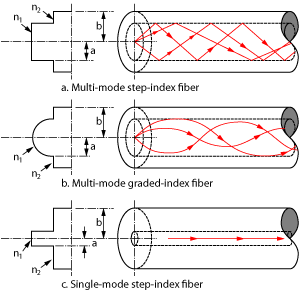 |
|
Fig. 1. Profiles of multi-mode step-index (a) and graded-index (b), and single-mode step-index (c) fibers. In a graded-index fiber, the index of refraction in the core decreases between the central axis and the cladding. Multi-path or modal dispersion is lower in a graded-index multi-mode fiber than in a step-index multi-mode fiber.
|
|
The primary material used in the manufacture of optical fibers for downhole use is high-quality silica (SiO2). This glass contains very low amounts of impurities, such as water or elements other than silica and oxygen. Small amounts of elements or materials called “dopants” are typically added to the core region of the glass to increase its refractive index. However, in the new single-mode fiber for SAGD and steamflooding, the core is pure, undoped silica. Dopants are added only to the cladding region to depress its refractive index.
Optical fibers also vary according to the nature of coatings protecting the glass fiber from the harsh environmental conditions. These coating are made of a combination of materials, including carbon, polyamides, silicone, steel and many chemical alloys.
SINGLE-MODE VS. MULTI-MODE FIBER
Multi-mode fibers have several advantages over single-mode fibers. The larger core sizes make it easier to launch light into the fiber and to make fiber connections. During fiber splicing, core-to-core alignment becomes less critical than it is in single-mode fiber. These advantages have propelled many commercial applications of multi-mode fibers in several industries.
Unfortunately, multi-mode fibers also have some disadvantages. Each individual mode propagates along the fiber at different speeds. This speed difference leads to modal dispersion, which causes light pulses to spread as they propagate down the fiber. As the number of modes increases, the effect of modal dispersion increases. Modal dispersion affects system bandwidth, and fiber manufacturers have adjusted the core diameter, refractive index profile and other parameters of multi-mode fibers to minimize modal dispersion and maximize system bandwidth.
Because a single-mode fiber supports only one guided mode, there is no modal dispersion. The fundamental advantage, however, is the ability of single-mode fibers to carry a higher capacity of information over very long distances with minimal loss of spatial and spectral integrity. This tremendous information-carrying capacity and low intrinsic loss have made single-mode fiber the ideal transmission medium for a multitude of longer-distance and higher-bandwidth applications.
The single-mode, pure-core fiber tested by JACOS has added advantages resulting from manufacturing changes that eliminate the need for germanium dopants in the core for refractive index grading. The pure silica core of the fiber makes it less susceptible to hydrogen damage, especially at higher temperatures, which is an obvious advantage for SAGD applications.
LABORATORY TEST
Under controlled laboratory conditions, the new single-mode, pure-core fiber demonstrated marked resilience over conventional fiber in the presence of hydrogen. Hydrogen molecules negatively impact the performance of optical fibers and their ability to accurately determine temperature profiles in two critical ways: hydrogen molecular absorption and molecular chemical reaction.
Hydrogen molecular absorption. SAGD operations designed for the production of high-viscosity hydrocarbons create a hydrogen-rich environment. Hydrogen molecules come from many sources, including the produced hydrocarbons, protective coatings around the glass fibers and corrosion of the metal tube or cable exterior. These free hydrogen molecules penetrate into glass and impair light transmission through the fiber.
This form of hydrogen damage affects all kinds of optical fibers, including the new single-mode fiber. Figure 2 compares the wavelength-dependent losses in conventional single-mode fiber with that of the pure-core fiber. The losses for these two fibers are essentially identical, demonstrating that the effects of molecular hydrogen absorption exist in the presence of hydrogen regardless of fiber type.
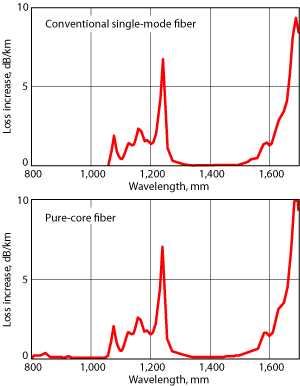 |
|
Fig. 2. Measured light loss resulting from hydrogen absorption in conventional single-mode fiber and in the new pure-core fiber as a function of wavelength are essentially identical.
|
|
As shown in Fig. 3, the rate of hydrogen molecular absorption is directly influenced by the temperature and partial pressure of hydrogen surrounding the fiber. However, once the hydrogen source is removed and the unreacted molecular hydrogen has time to diffuse out of the fiber, the light loss in the new fiber returns to its original value. In other words, hydrogen darkening from molecular hydrogen is reversible.
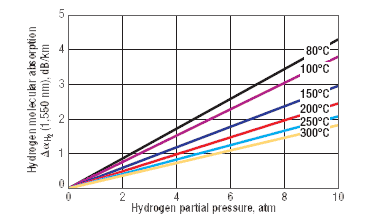 |
|
Fig. 3. Hydrogen absorption rate is a function of temperature and partial pressure of surrounding hydrogen.
|
|
Hydrogen chemical reaction. Conventional single-mode and multi-mode fibers are made up of SiO2 and GeO2. When hydrogen diffuses into the core of a conventional fiber, it can react chemically with the dopants and other impurities in the fiber to form stable chemical compounds. These new chemical species can increase light loss or attenuation, and can remain in place even if molecular hydrogen is removed. In other words, hydrogen darkening due to chemical reactions in fibers is non-reversible.
On the other hand, the pure-core fiber used in the JACOS well has a core region made of pure silica, without dopants. In the absence of dopants, hydrogen cannot react with impurities to form absorptive molecules in the core, leaving the pure-core fiber resistant to any chemical reactions due to hydrogen ingression, even at elevated temperatures.
As shown in Fig. 4, there is almost no light loss resulting from hydrogen molecular reaction in the new pure core optical fiber. However, significant losses are observed in conventional single-mode fiber with a germanium-doped core.
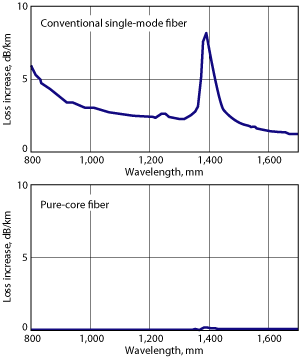 |
|
Fig. 4. Significant light losses due to hydrogen molecular reaction are observed in conventional single-mode optical fiber with a germanium-doped core, but there is almost no light loss in the new pure-core fiber..
|
|
FIELD TEST
The extreme conditions of SAGD operations require optical fibers used in DTS applications to resist hydrogen ingression under high partial pressures and to withstand high temperatures. The JACOS well provided just such an environment for testing these capabilities.
This horizontal SAGD well typically operated within a temperature range of 200-300°C. The well was equipped with a U-type capillary tube through which optical fibers could be run, and was monitored with thermocouples, which provided temperature readings at three fixed points along the well.
A conventional multi-mode fiber and the new single-mode, pure-core fiber were installed in opposite sides of the looped capillary tube. This configuration provided an excellent setting for side-by-side comparisons of DTS system performance over time.
Throughout the 20-month trial, temperature data for both the conventional multi-mode fiber and the new single-mode fiber were compared to the multiple thermocouples.
Multiple Optical Time Domain Reflectometry (OTDR) readings were recorded at fixed time intervals throughout the duration of this field test to ascertain the degree of light loss occurring across the entire fiber in the harsh downhole conditions over extended periods of time. For the new single-mode, pure-core fiber, the OTDR information was recorded using laser pulses of 850-nm, 1,310-nm and 1,550-nm wavelengths. Similarly, OTDR data was recorded for the conventional multi-mode fiber at 850-nm, 1,300-nm and 1,550-nm wavelengths.
RESULTS
The Raman Stokes and Anti-Stokes readings from the new fiber are presented in Fig. 5. These readings compare very well with data from the conventional multi-mode fiber (Fig. 6), which shows rapid deterioration of both the Stokes and Anti-Stokes readings, albeit at different rates. Higher loss rates in the conventional fiber were observed for the Anti-Stokes values than for the corresponding Stokes readings over the same time regime.
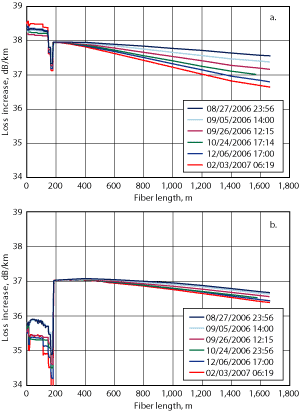 |
|
Fig. 5. Long-term Raman Stokes (a) and Anti-Stokes (b) readings for the new pure-core fiber.
|
|
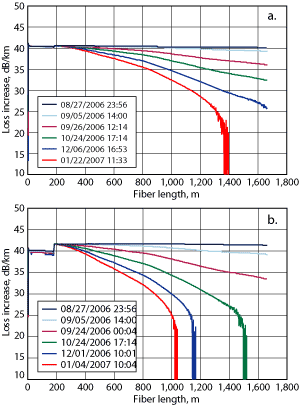 |
|
Fig. 6. Readings from the conventional multi-mode fiber show rapid deterioration of both the Stokes (a) and Anti-Stokes (b) readings, albeit at different rates.
|
|
Unequal changes in light loss for the Stokes and Anti-Stokes wavelengths adversely affected temperature readings recorded by the conventional multi-mode fiber, while the single-mode, pure-core fiber continues to record good temperature data for long-term monitoring of the well.
Figure 7 presents field trial temperature recordings from August 2006 through January 2007. These DTS temperature profiles are plotted against the recordings from the thermocouples located at the toe, middle and heel of the horizontal well. While the conventional fiber demonstrated good temperature readings for the first few days after the commencement of SAGD operations, temperature measurements degraded profoundly within a week, and more recent temperature measurements are extremely inaccurate. Meanwhile, the pure-core fiber continued to provide quite accurate temperature data from the SAGD producer after more than five months of operation.
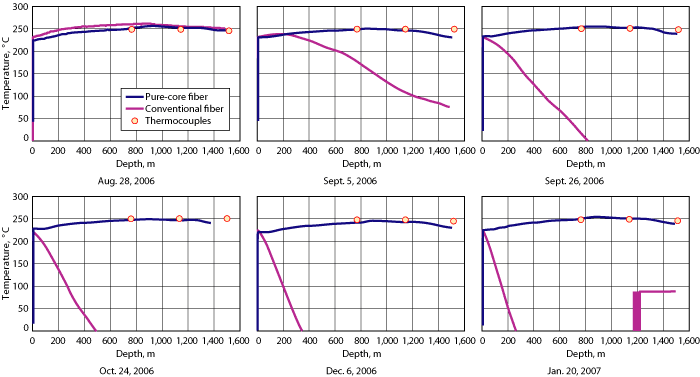 |
|
Click Image to Enlarge.
Fig. 7. Temperature recordings from August 2006 through January 2007 are plotted for the two fibers and for the thermocouples located at the toe, middle and heel of the SAGD well. Measurements from the conventional fiber degraded profoundly within a week, and became more inaccurate over time, while the pure-core fiber continued to provide accurate data after more than five months.
|
|
CONCLUSIONS
The new DTS system using a single-mode, pure-core glass fiber was shown in the JACOS well trial to minimize hydrogen molecular reactions with impurities from the manufacturing process.
The new temperature calculation algorithm employed by the system to account for minor reversible hydrogen absorption has permitted good temperature data gathering from the SAGD producer used for the field trial. Light loss traces for this fiber show some loss at long wavelengths, but not at shorter wavelengths.
Comparison of the new fiber performance with that of a conventional multi-mode DTS system clearly demonstrates that the conventional DTS system did not provide good temperature data after the first few days of operation. Light loss in this fiber continued to degrade severely for all three wavelengths tested. 
ACKNOWLEDGEMENT
This article was prepared from WHOC 2008-365 presented at the World Heavy Oil Congress in Edmonton, Alberta, March 10-12, 2008. The authors thank JACOS and WellDynamics management for allowing them to publish the findings, and David Johnson for his sustaining support and assistance throughout the course of the project.
BIBLIOGRAPHY
Drakeley, B. K., Johansen, E. S., Zisk, E. J. and F. X. Bostick, “In-well optical sensing: State-of-the-art applications and future direction for increasing value in production-optimization systems,” SPE 99696 presented at the SPE Intelligent Energy Conference and Exhibition, Amsterdam, April 11-13, 2006.
Kragas, T. K., Williams, B. A. and G. A. Myers, “The optical oil field: Deployment and application of permanent in-well fiber optic sensing systems for production and reservoir monitoring,” SPE 71529 presented at the SPE ATCE, New Orleans, Sept. 30-Oct. 3, 2001.
Krawchuk, P., Beshry, M. A., Brown, G. A. and B. Brough, “Predicting the flow distribution on Total E&P Canada’s Joslyn project horizontal SAGD producing wells using permanently installed fiber-optic monitoring,” SPE 102159 presented at the SPE Annual Technical Conference and Exhibition, San Antonio, Texas, Sept. 24-27, 2006.
Noguchi, K., Shibata, N., Uesugi, N. and Y. Negishi, “Loss increase for optical fibers exposed to hydrogen atmosphere,” Journal of Lightwave Technology, 3, No. 2, 1985, p. 236.
Normann, R., Weiss, J. and J. Krumhansl, “Development of fiber optical cables for permanent geothermal wellbore deployment,” SGP-TR-168 presented at the 26th Workshop on Geothermal Reservoir Engineering, Stanford University, Stanford, Calif., Jan. 29-31, 2001.
Wang, C. et al., “High-performance hermetic optical fiber for downhole applications,” SPE 91042 presented at the SPE ATCE, Houston, Sept. 26-29, 2004.
|
THE AUTHORS
|
|
|
Jiten Kaura is a global technical adviser in the Fiber Optic Technology group at WellDynamics, and has more than 12 years of experience in the oil and gas industry in a variety of roles. He spent six years in the Middle East with Halliburton, where he serviced the customer base in well testing, completions and fracturing flowback. He later served as a technology leader for Halliburton–Indonesia. In his current role with WellDynamics, Mr. Kaura performs candidate screening for the application of fiber optic technology and studies fiber installation compatibility issues. He also performs analytical work on the data collected.
|
|
|
|
Jose Sierra is a senior global adviser in the Fiber Optic Technology group at WellDynamics in Houston. He has over 36 years of experience, both with Petroperú as geologist, reservoir engineer and multidisciplinary project team leader and at Halliburton, where he held roles in technical support and in transfer of new technologies. Mr. Sierra has led worldwide projects in well evaluation, production enhancement and reservoir monitoring, and has developed software to analyze well logs, well tests, hydraulic fracturing and DTS data. He teaches courses in these disciplines, holds a BS degree in geology, and is member of SPE, AAPG and SPWLA.
|
|
|











